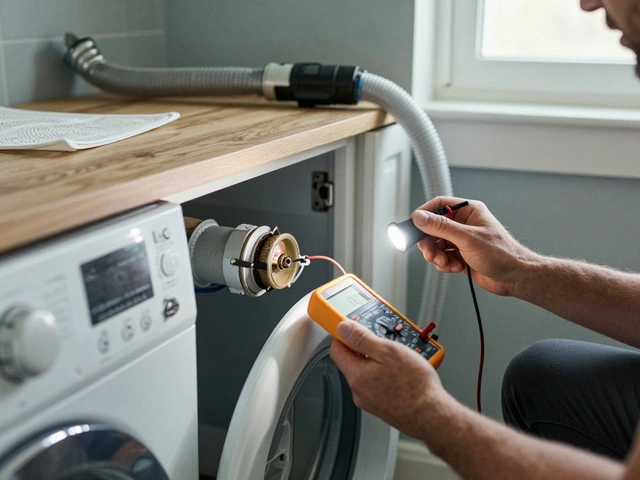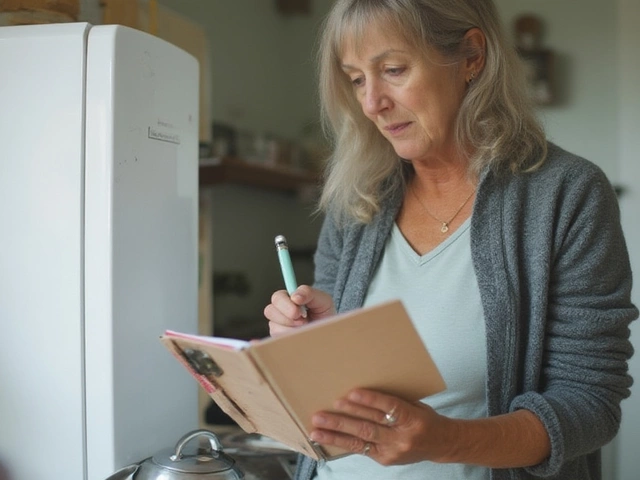Having your electric hob stop working can quickly turn a seamless cooking experience into a frustrating one. It's a vital component in your kitchen, and when it malfunctions, it can cause significant inconvenience. But before you reach for the phone to call in a repair service, there are some steps you can take to troubleshoot the issue. Understanding the common problems and possible fixes can save you time and money.
In this article, we'll delve into the various reasons your hob might have stopped working and provide practical steps to diagnose and potentially resolve the issue. Whether it's performing an initial check on the power supply or taking a closer look at the heating elements, these tips could help get your appliance up and running again. Stick around as we explore the most likely culprits and offer advice on when it's best to bring in a professional.
- Initial Troubleshooting Steps
- Electrical Components Check
- Common Hob Issues
- When to Call a Professional
Initial Troubleshooting Steps
When your electric hob suddenly loses its sizzle, the first impulse might be panic. But fear not, as there are several initial steps you can take before calling in the cavalry. Begin by checking the power source. Often enough, it's a simple matter of a loose plug or a tripped circuit breaker. Make sure your hob is securely connected to the power outlet. If your kitchen goes dark every time you switch on the hob, it could be an overloaded circuit causing the power to cut. This is the time to visit your circuit breaker box and ensure it hasn’t tripped. When a breaker trips, it disrupts the electrical flow to prevent overheating and potential fire hazards.
Once you're certain that power is reaching the hob, it’s essential to examine any visible signs of damage. Look for frayed wires or burn marks around the power chord which might indicate overheating or short circuits. Also, upon closer examination, you might find that food debris obstructing the knobs or buttons. Resort to using a soft, damp cloth to wipe the control panel clean. This step isn’t just about tidiness; it clears any obstructions that might interfere with the hob’s electronic controls. Cleaning the controls thoroughly yet gently prevents accidental changes while cooking and ensures optimal functionality.
Another key aspect involves carefully listening for any unusual noises when switching the hob on. Strange sounds could signal internal issues that might warrant professional attention. However, if you hear nothing at all, it could suggest a problem with the hob’s power supply rather than its components. At times, confronting a failure to heat can be disheartening. You could bypass this by ensuring all parts, such as detachable hot plates or coil elements, are properly seated in their respective slots. Some models incorporate safety mechanisms that disable heating if elements are not correctly placed.
Don't forget to consult the hob's user manual during this phase. This often overlooked resource can provide device-specific insights and troubleshooting tips. As reiterated by famous repair expert James Heatley,
"Understanding your appliance's unique specifications can often lead to the solution without the need for professional assistance."Taking the time to read through the manual can reveal model-specific idiosyncrasies that are critical in resolving operational hiccups.
While working through these initial steps, it's crucial to keep safety at the forefront. Ensure that the hob is turned off and disconnected from the power source when inspecting or adjusting any components. By methodically working through these fundamental checks, many common issues can be resolved swiftly, transforming what could have been a culinary catastrophe into a mere hiccup in your kitchen-based endeavors.

Electrical Components Check
When your electric hob gives you trouble, the issue might lie within its electrical components. The first thing to consider is the power supply. If the appliance isn’t receiving power, it won't function as expected. Start by checking if it's plugged in securely; sometimes, a loose plug is all it takes to disrupt a steady power flow. Ensure the circuit breaker for your kitchen hasn't tripped—that’s a common reason for sudden power loss. If you find the breaker tripped, try switching it back on, but if it continues to trip, that might indicate a deeper issue requiring a professional’s help.
Inspecting the hob’s wiring can be more challenging but may be essential. Look out for any visible signs of wear and tear on power cords. Damaged wiring could cause functionality issues or even pose safety hazards. Carefully examine each connection to ensure they're secure, and if you're not comfortable doing this, it's best to consult an electrician. They can use voltage testers to safely verify whether electricity is passing through each part.
Another component worth checking is the hob's internal fuse. Most appliances like these have a built-in safety fuse designed to protect internal components. If your hob suddenly stops working and there's no sign of power, a blown fuse might be the culprit. Replacing a fuse can often be as simple as following the manufacturer’s instructions, but be sure to use the correct fuse rating specified for your hob’s model. Using an improper fuse can cause further damage or even void warranties.
Testing the Heating Elements
The heating elements in your hob could also be at fault. Each element is part of a complex electrical circuit that must be intact for your hob to operate effectively. Examine them for any visible damage, like cracks or discoloration, which might suggest overheating or electrical faults. In some cases, replacing a single faulty element is all it takes to restore your hob to working order.
"Electrical components in appliances are intricately designed to work as part of a system. When one element fails, it can create a chain reaction impacting performance," says Jon Stevens, a renowned appliance technician.
Don't forget about the control knobs and touch panels, as they orchestrate the operation of the heating elements. If a knob feels loose or a panel unresponsive, these might need recalibration or replacement. Ensuring the hob's controls are working correctly can often nip functionality issues in the bud before they escalate.
If you're the data-oriented type, here's a small table to illuminate which components often require attention:
| Component | Common Issue |
|---|---|
| Power Supply | Loose plug or tripped breaker |
| Internal Fuse | Blown fuse |
| Heating Elements | Cracks or discoloration |
| Control Knobs | Loose connection |
Tackling the electrical components might require patience and a keen eye, especially since handling anything electrical comes with its set of risks. If a solution to your hob troubles isn't readily clear, it might be best to contact a professional. However, with a bit of persistence and care, you can quite possibly identify and resolve numerous common electric hob issues yourself, saving on unnecessary repair fees and prolonging the life of your cherished kitchen appliance.

Common Hob Issues
The electric hob, a staple of contemporary kitchens, can experience a range of common issues that interrupt its functionality. These problems can be frustrating, especially when you're mid-recipe. One frequent hitch is the hob not heating properly or failing to heat up at all. This might be traceable back to faulty appliance troubleshooting. Ideally, the hob should heat up swiftly once switched on, but if this isn't happening, the fault could lie in a malfunctioning heating element. Over time, these elements can wear out, leading to inconsistent temperatures or complete failure. Regular use can exacerbate this wear and tear, necessitating more frequent checks.
Another prevalent issue involves the controls. If the dials or touchpads become unresponsive, it can be a sign of electrical problems underneath the surface. Grease and grime, common in kitchen environments, can accumulate and impede the performance of these controls. Keeping these surfaces clean is vital. If you have an induction hob, specific cookware is essential for proper functioning. Induction hobs use electromagnetic energy, which requires pots and pans with an iron base to generate the required heat. Without the correct cookware, you may think your hob is broken, when in reality, it's just a matter of switching to compatible utensils.
Problems with the power supply can often seem the most daunting. Power issues might manifest as the hob not turning on at all. This isn't always a hardware problem – sometimes, it stems from a tripped circuit breaker. It's worth checking your home's electrical panel before assuming the worst. A poor connection within the power supply might also cause intermittent functionality of the hob. According to a survey by the Association of Home Appliance Manufacturers, “almost one-third of all appliance breakdowns are related to power issues, either in the home or within the device itself.”
More complex issues include strange noises emanating from the hob. Hissing or buzzing sounds could indicate electrical arcing within the unit, which is a potential fire hazard and warrants immediate attention. It's crucial to resolve such issues swiftly to prevent escalation. Sometimes, the problem isn't the hob itself but rather the outlet or wiring connected to it. For those who are not electrically savvy, calling a professional might be the safest course of action. Still, understanding the potential points of failure within your electric hob can aid in discussing the problem with repair technicians effectively.

When to Call a Professional
Sometimes, despite our best efforts and determination, an electric hob's issue might be beyond the scope of a do-it-yourself fix. Knowing when to call a professional can save you from further damage and additional costs in the long run. After all, safety comes first, especially when dealing with electrical appliances. If your electric hob continues to behave erratically or refuses to work after attempting basic troubleshooting, it might be time to bring in the experts who have the right tools and expertise to diagnose more complicated problems. They can handle issues like faulty wiring or complex circuit failures that require specialized equipment and technical knowledge.
One common scenario that warrants professional intervention is when there is a persistent electrical smell or visible scorch marks on your appliance. This may signal a serious electrical fault that could pose a fire risk if left unattended. Another sign is if you've blown a fuse or tripped your circuit breaker multiple times while trying to use the hob. This could indicate underlying electrical issues that need to be addressed by an electrician. Not only should you be concerned about the immediate functionality, but these issues could also indicate deeper problems in the electrical system of your house.
Additionally, if one or more heating elements have stopped working and replacing them does not restore their functionality, expert assessment is necessary. Professionals can also help if the hob's touch controls or mechanical knobs remain unresponsive or malfunction, as these could require careful recalibration or replacement. Calling in a professional can ensure that any repairs are done safely and in compliance with local electrical codes. If unsure, it's always better to err on the side of caution and consult an expert.
If you’ve just moved into a new place and suspect an issue with an inherited hob, or if your appliance is still under warranty, these are good reasons to avoid a DIY approach. Many warranties require that repairs be carried out by certified technicians to remain valid. Remember, while the upfront cost of hiring a professional might seem high, it could save you from more expensive repairs in the future. As the Federation of Small Businesses notes, "Professional service can often save homeowners significant resources by avoiding improper repairs."
"Investing in professional repair might be the difference between a minor fix and a major renovation."





